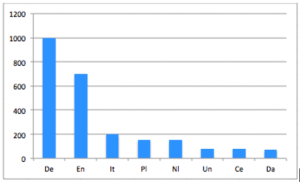How SalzburgerLand.com is engaging travelers and outperforming competitors
SalzburgerLand Tourismus, while looking for an effective content marketing strategy to lure travelers, decided to build its own knowledge graph along with a new WordPress powered website. The Austrian regional tourism agency, after the first 6 months, has outperformed the competition: compared with 161 websites from the same industry and with a similar range of traffic, Salzburgerland.com had acquired 92.65% more users via organic search. Wanna know how? Follow me and discover one of our best SEO case studies.
Building the digital pathways to bring travelers in SalzburgerLand
SalzburgerLand Tourismus (SLTG) is the agency responsible for marketing, development, and promotion of tourism in the region of Salzburg. Its main challenge is to attract and engage travelers from around the world, to meet their needs at the right time and to develop new travel products.
«The strategic orientation of SLT is to transport main topics and highlights matching the needs and requirements of different markets and channels. On that point we are forcing the use of visual components (pictures, videos, cinemagraphs) to create emotions and to engage guests. At the same time we endeavor to deliver relevant information to every single traveler.
Using WordLift (and WordLift Cloud) we are now able to structure our content, make it readable for machines to serve personal assistants like Alexa, Google Home or any other smart device – and to share it with our partners.»
Rainer Edlinger and Martin Reichhart, Digital Media Managers at SalzburgerLand Tourismus
Nowadays travelers, in most cases, begin their exploration from Google. The search engine has become the place where people from different countries browse for ideas and dream about their future travel experiences. They use Google to look for the dates, flights, and hotels that match their expectations. Ultimately, with Google evolving into the biggest online travel agency worldwide, it has become strategic to reach customers at the right time during their journey by promoting top-notch content with both paid and organic positioning.
We’ve been collaborating with SLTG since 2014 to grow their organic traffic and to implement an open linked data content marketing strategy. Salzburgerland.com is SLTG’s main online property and at the very center of a distributed network of online services (mobile websites, mobile apps, social media accounts and so on). The goal of the site has always been to attract world travelers from around the world with first-in-class engaging content.
As a background activity to focus on the needs of SLTG, we have been studying travelers’ behavior using regional open data on inquiries, bookings, and visits along with search intents. This analysis helped us define (and re-define) market segments, personas, and information needs for each target group.
After analyzing the core business targets, the team drafted a set of traveler marketing personas and moved ahead with:
- Migrating to WordPress
- Organizing existing and new content around different travelers
- Creating an enterprise knowledge graph – a semantic database that describes all concepts that matter: these are the key building blocks of the information architecture of the new website.
#1 Migrating to WordPress: a strategic choice
Salzburgerland.com used to manage its content using an in-house developed Content Management System until they decided, back in 2016, to migrate to WordPress. There are several reasons for large organizations like SLTG to switch to an open source web CMS like WordPress:
- Continuous update of the technology with a controlled ICT budget. Automattic and the community around WordPress are responsible for updating the core of the CMS. Clients, like SLTG, need to run constant testing on all new releases of the software but all the development is open source and available to anyone for free.
- Increased flexibility in creating new content and a streamlined publishing workflow. This helps the editorial team focus on what really matters: great content that travelers want to read.
- The wide range of plugins available for WordPress, while overwhelming at the beginning, and sometimes extremely confusing, helps lower the cost of new developments on large websites.
- Improved performances when compared to other legacy systems, WordPress is fast (especially when combined with proper caching technologies and optimization tools).
#2 Organizing existing and new content around different travelers
Travelers from different countries have different information needs. Salzburgerland.com uses a multi-language website (and data) structure offering different content for each target group.
Tourists are provided with appropriate navigation paths each one starting with a particular landing page. Each landing page is an entity that corresponds to a specific geographical location, an area of interest, an organization or a type of travel experience.
#3 Creating an enterprise knowledge graph
The core of the new strategy for SLTG was not to revamp their website, but to create their own enterprise knowledge graph using linked data and semantic technologies. Organizations like SLTG integrate heterogeneous data from different sources and with a semantic database, all this data is made accessible to everyone.
The enterprise knowledge graph helps infer new relationships out of existing facts, giving context and meaning to editorial content. SLTG has been experimenting over the years with semantic technologies, to gain a competitive advantage, to support their internal business decisions and to create new applications and touch points for the travelers.
As the new portal was being designed the content has been semantically structured using WordLift to connect at best with their target audience (travelers from Austria, Germany, Netherlands, Italy and more) and to share their knowledge with their partners.
Wondering about how to run a data-driven content marketing?
Let’s talk about it.
What benefits come from building a knowledge graph?
With WordLift, SLTG has been able to:
- Provide immediate access to travel information for both travelers and machines (including crawlers and chatbots) — on large properties, it’s simply impossible to manually add structured data.
- Drive more traffic, from Google — this is true when compared to other travel websites and similar institutions in Austria and around Europe, thanks to an improved content architecture and to the semantic markup.
- Engage with travelers meeting them exactly when they are dreaming about inspiring places to visit and while they are scouting for new updates and information on SalzburgLand.com.
- Improve the UX providing a new enriched content model to help travelers discover Salzburg Land and its breathtaking sites.
- Release an Open Linked Data infrastructure to make all the information published on the site available to third parties (Hotels, Travel Agencies, Booking Systems, and more) as open data.
On Salzburgerland.com WordLift entities are used as landing pages for different market segments: almost 2.500 entities in eight languages make up the starting vocabulary and perform as search magnets for organic traffic.
Salzburgerland.com Entities per language
To keep the good work up, editors are regularly creating new content around entities and adding new entities (based on the information that the semantic databases reveal to the marketing team).
The new Salzburgerland.com has been online since the end of January 2017. We have been able to look at the metrics and to benchmark the results against other travel websites (and yes, competition, especially in Austria in the sector of tourism, is extremely fierce ? ).
Between February 2017 and July 2017, the site has acquired via organic search 148.166 new users. When compared to other 161 online properties (using Google Analytics benchmarking tool) in Austria (with similar traffic) this is 92.65% more than anyone else. Salzburgerland.com, so far, has been really outperforming its competitors. ?
Here is how linked data helps Google Assistant respond to an English speaking traveler about a series of event called “Bauernherbst” (the German word for Harvest Festival)
What’s next?
Salzburgerland.com’s enterprise knowledge graph is now available on open.salzbugerland.com. This dataset describes points of interest, main sites, events and any attraction for travelers in the region. Application developers and partners can now directly use data from the enterprise knowledge graph.
Using the data portal is possible to interact directly via the endpoint in SPARQL. Try it yourself, and look for the list of events grouped by town.
We’re now working on integrating other data sources into the graph to boost the SEO of all the websites in the SLTG network. Moreover, the team is working on reusing the data to create a new voice activated digital experience using Alexa and the Google Assistant.
Working with SLTG for us over these years has been a terrific experience and a lot of the enhancements in today’s product are the results of the fruitful collaboration between our startup and their digital marketing team. Besides being truly in love with this charming region of Austria we’re extremely grateful for all the support, brilliant insights and opportunities that SLTG has shared with us. ?





